The Christmas Bird Count has come and gone but there’s still plenty of fun birding activity to be had during the Valley’s winter migratory bird season.
For last week’s Harlingen Christmas Bird Count, all the usual suspects were around our yard. I counted 236 birds in 34 species during the morning hours while I sat near the resaca with scope, binoculars and camera.
It was a lovely, pleasant-temp and sunny day. The cats sat with me until bugs and other active creatures got their attention and they raced off.
The most exciting photos of the day were the juvenile black-crowned night-heron and its parent as those birds were in good range for clear photos.
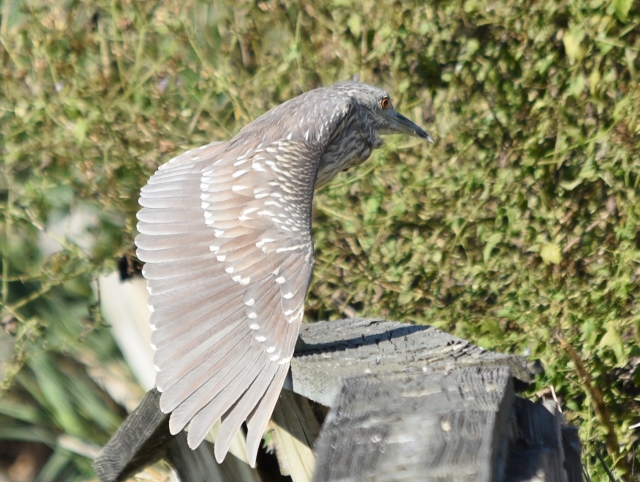
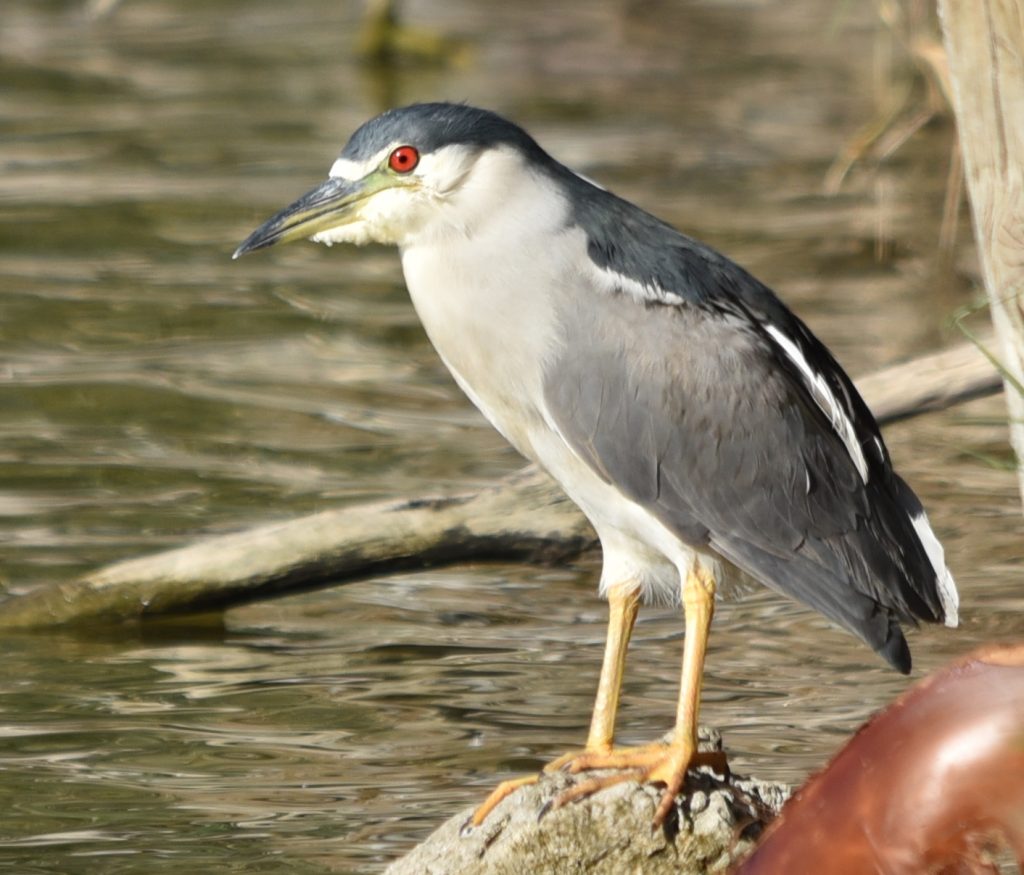
I wrote about night-herons for the McAllen Monitor in our Texas Master Naturalist column that publishes the third Saturday of each month. A brief excerpt of that story is toward the end of this post at Night-herons.
But first:
Winter Outdoor Wildlife Expo — WOWE — is just around the corner.
Tuesday through Saturday — January 22 – 26
There are many opportunities to volunteer and attend presentations and bird walks.
Check out the schedule of activities at this link: https://www.spibirding.com/wowepresenters
Tuesday — Plants and Pollinators
Wednesday — Fishing Day
Thursday — The Gulf and the Bay
Friday – South Texas Birds
Saturday — Nature of the Valley
Tuesday Plants and Pollinators day offers a talk by one of our partner organizations — Cameron County Master Gardener Advisor and AgriLife Extension Service Horticulture Agent Jennifer Herrera and CCMG and Texas Master Naturalist Janet Schofield will be presenting A New Look at Composting. This is great stuff. It’s informative, do-able and you’ll think, why haven’t I done this before?

Then at WOWE’s Friday bird day you’ll get help honing bird identification skills so you can participate in another exciting annual birding event:
The Great Backyard Bird Count, February 15-18 — check out
https:// www.gbbc.org
Now for the promised excerpt from the McAllen Monitor monthly Texas Master Naturalist native plant column.
Night-herons:
Black-crowned night-herons are social birds and tend to roost and nest in groups. During the day, across the resaca, some 35 night-herons had been concealing themselves among branches and foliage of the trees on the far bank. True to their name, night-herons forage generally in evening and at night in water and on land. Black-crowned night-herons are opportunist feeders and eat many kinds of land and marine animals, including insects, earthworms, crayfish, clams, fish, lizards, snakes, rodents, carrion, and garbage from landfills.
Their Valley habitat is near wetlands, marshes, resacas and irrigation ditches.
Yellow-crowned night-herons are more solitary than black-crowned night-herons although they will roost near the larger scattering of black-crowned night-herons. The yellow-crowned feed primarily on freshwater and saltwater crustaceans and many species of crabs.
The stealth of night-herons had mysteriously arrived in the dark of a late December night, without pomp, to set up camp in the lower shrubs on the opposite shore of the resaca.
One morning, they were just simply there, quiet, but completely noticeable white blotches, like statues, perched in the lower branches of the shrubs.

Just as quietly, soon after the Christmas bird count, the night-herons had moved on!
Pulling a photo into a close crop revealed a couple of yellow-crowned night-herons, too, with their navy-blue and white facial markings and their pale yellow crowns, which distinguish them from the dark gray cap and “cape” of the black-crowned night-heron.
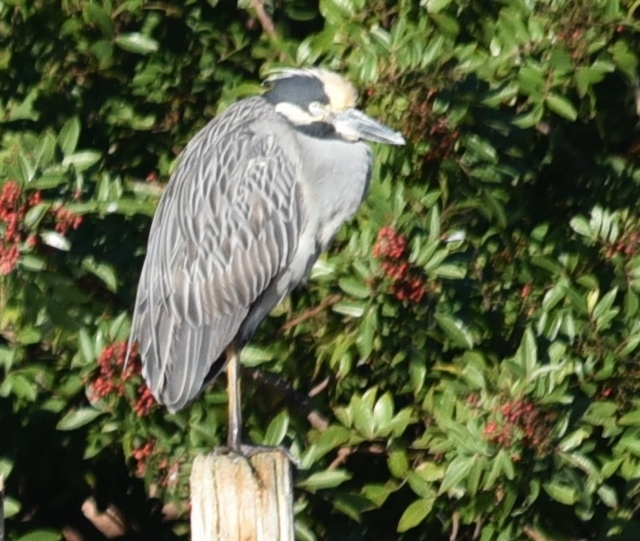
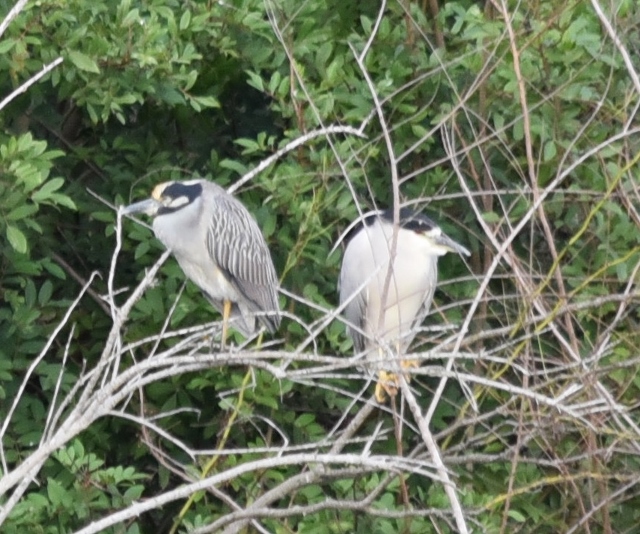
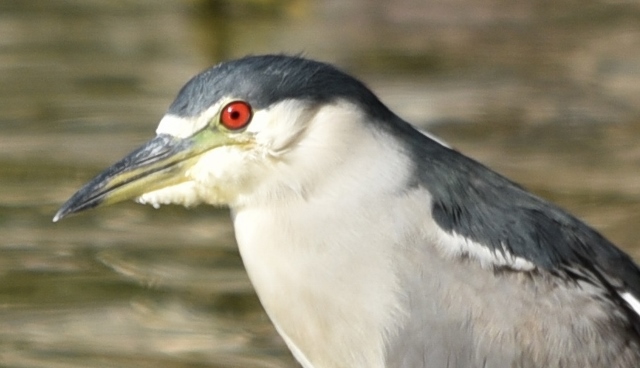
A fun discovery during the bird count was an unusual brilliant flash of red. Thinking it one half of our resident pair of northern cardinals, I took a gander through the scope and saw a vermilion flycatcher — woo-hoo! Another box checked for the count and a quick photo “for ID purposes only.”
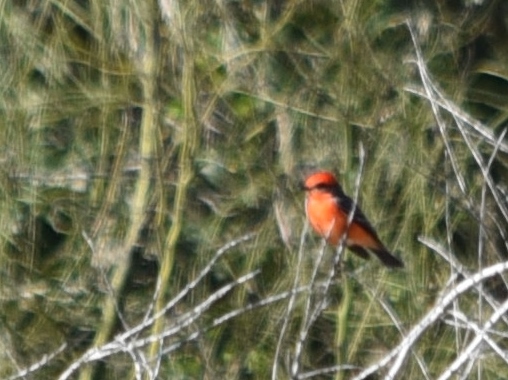
It’s but a speck in the photo but the brilliant-red underparts are strikingly visible as are the dark blackish brown upperparts and wings and the blackish brown lores (region between eyes and nostrils of birds) and mask joining at the nape.
Take advantage of all the opportunities to learn about the interesting birds that winter over here.
Happy birding in the coming weeks. The weather AP on my phone promises pleasant weather!
Note: For the collective-bird-noun-lovers, I used the words, scattering and stealth, instead of the word, flock, when describing the groups of night-herons.
2019 Christmas Bird Count — Harlingen Count Circle Wrap-up
Thank you to Arroyo Colorado Audubon Society President Norma Friedrich for the tallies:
There were 8 feeder watchers who turned in a total of 56 species of “yard birds.”
The total species for our Harlingen Count Circle was 162 with some still pending per documentation of rare species. We have about 4 of those.
Total numbers of birds counted was 48,319 with Great-tailed Grackle at the top of the list with 18,559 counted, next came Red-winged Blackbirds with 7,379 followed by Black-bellied whistling ducks at 2,911.
Some birds requiring documentation due to being rare to the valley or rare at this time of year were Wood Stork, Cactus Wren, Dickcissal, Ovenbird, Wood Thrush, Indigo Bunting, Sedge Wren, Gray Hawk, Gray Catbird, Baltimore Oriole and Bullock’s Oriole.
